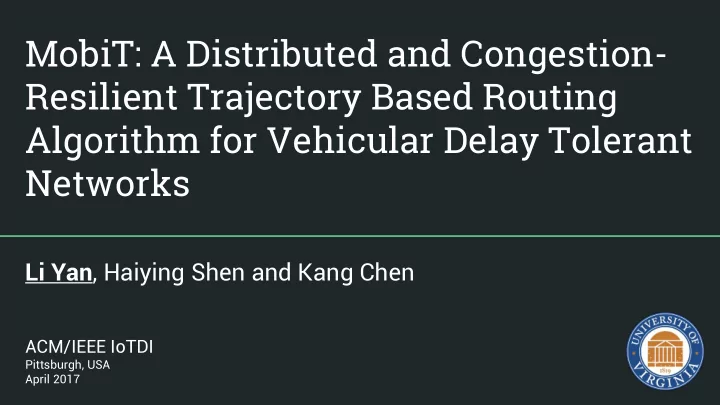

MobiT: A Distributed and Congestion- Resilient Trajectory Based Routing Algorithm for Vehicular Delay Tolerant Networks Li Yan , Haiying Shen and Kang Chen ACM/IEEE IoTDI Pittsburgh, USA April 2017
2 Playground for VDTNs Limited bandwidth, sparse communication infrastructure Such as:
3 Playground for VDTNs Limited bandwidth, sparse communication infrastructure Such as:
4 Playground for VDTNs Limited bandwidth, sparse communication infrastructure Such as:
5 Why is packet delivery in VDTNs non-trivial?
6 Why is packet delivery in VDTNs non-trivial? Highly dynamic mobility of • vehicles Disconnected nature of • VDTNs
7 Why is packet delivery in VDTNs non-trivial? Highly dynamic mobility of • vehicles Disconnected nature of • VDTNs Efficient and accurate delivery of packet is not easy
8
9 1 Use vehicles’ historical meeting records to schedule packet forwarding Insufficiently accurate
10 1 2 Use vehicles’ historical Use vehicles’ trajectories to meeting records to schedule schedule the delivery of packet forwarding packets Insufficiently accurate Depend on extra APs
11 MobiT: Packet routing method using Mobility derived from Trajectories C D 8:30AM B A Destination Relay Source Service Friend
12 MobiT: Packet routing method using Mobility derived from Trajectories Source vehicle – starting vehicle of the packet C D 8:30AM B A Destination Relay Source Service Friend
13 MobiT: Packet routing method using Mobility derived from Trajectories Source vehicle – starting vehicle of the packet Destination vehicle – target of the packet C D 8:30AM B A Destination Relay Source Service Friend
14 MobiT: Packet routing method using Mobility derived from Trajectories Source vehicle – starting vehicle of the packet Destination vehicle – target of the packet Relay vehicle – intermediate vehicle in the C D forwarding of the packet 8:30AM B A Destination Relay Source Service Friend
15 MobiT: Packet routing method using Mobility derived from Trajectories Source vehicle – starting vehicle of the packet Destination vehicle – target of the packet Relay vehicle – intermediate vehicle in the C D forwarding of the packet 8:30AM Friend vehicle – shares similar mobility with B A the destination vehicle Destination Relay Source Service Friend
16 MobiT: Packet routing method using Mobility derived from Trajectories Source vehicle – starting vehicle of the packet Destination vehicle – target of the packet Relay vehicle – intermediate vehicle in the C D forwarding of the packet 8:30AM Friend vehicle – shares similar mobility with B A the destination vehicle Destination Relay Source Service Friend Service vehicle – vehicle with stable trajectory
17 Overview Design of MobiT Experimental results Conclusion with future directions
18 Representation of Short-term Vehicle Mobility Vehicle trajectory
19 Representation of Short-term Vehicle Mobility Vehicle trajectory Table I: Table of road segment delays
20 Representation of Short-term Vehicle Mobility Vehicle trajectory Table II: Table of road segment Table I: Table of road segment delays congestion state
21 Representation of Short-term Vehicle Mobility Vehicle trajectory Table II: Table of road segment Table I: Table of road segment delays congestion state Estimate travel time of the trajectory
22 Representation of Long-term Vehicle Mobility … Vehicle routine T s : 08:10~08:20 T s : 13:00~13:20 T e : 08:30~08:45 T e : 13:30~13:45
23 Representation of Long-term Vehicle Mobility … Vehicle routine T s : 08:10~08:20 T s : 13:00~13:20 T e : 08:30~08:45 T e : 13:30~13:45 Table III: Table of routines
24 Representation of Long-term Vehicle Mobility … Vehicle routine T s : 08:10~08:20 T s : 13:00~13:20 T e : 08:30~08:45 T e : 13:30~13:45 Table III: Table of routines
25 Representation of Long-term Vehicle Mobility … Vehicle routine T s : 08:10~08:20 T s : 13:00~13:20 T e : 08:30~08:45 T e : 13:30~13:45 Table III: Table of routines Table IV: Table of friends
26 Routing Process based on Vehicle Mobility Destination Forwarder Source N 2 1 B N 1 D C A Complete list of forwarders
27 Routing Process based on Vehicle Mobility Destination Forwarder Source Destination Forwarder Source N 2 N 2 1 2 B B N 1 N 1 D C A D C A Complete list of forwarders Incomplete list of forwarders
28 Routing Process based on Vehicle Mobility Destination Forwarder Source Destination Forwarder Source N 2 N 2 1 2 B B N 1 N 1 D C A D C A Complete list of forwarders Incomplete list of forwarders Use long-term mobility 3 No short-term mobility Rely on service vehicle
29 Performance evaluation Vehicle mobility traces Comparison methods Robust Replication Routing (R3): Mobicom’11 Rome [1]: 30-day taxi trace with 315 taxis and 4638 landmarks Shared-Trajectory-based Data Forwarding (STDFS): Infocom’11 [1] R. Amici, M. Bonola, L. Bracciale, P. Loreti, A. Rabuffi, and G . Bianchi, “Performance assessment of an epidemic protocol in VANET using real traces,” in Proc. of MoWNeT, 2014.
30 Performance evaluation (cont.) Metrics Average Average Success Average number of vehicle rate delay information memory queries usage
31 Performance evaluation (cont.) Rome: MobiT>STDFS>R3 R3>STDFS>MobiT
32 Performance evaluation (cont.) Rome: STDFS>MobiT>R3 R3>Service>MobiT>STDFS
33 Summary 1. By utilizing vehicles’ trajectories, MobiT can schedule the forwarding of packets in a distributed manner. 2 . Through combining the vehicles’ long -term mobility with their short-term mobility, MobiT can realize accurate and efficient delivery of packets with limited overhead. 3 . In the future, we will further exploit vehicles’ social relationship for the routing of packets.
34 Thank you! Questions & Comments? Li Yan, PhD Candidate ly4ss@virginia.edu Pervasive Communication Laboratory University of Virginia
Recommend
More recommend